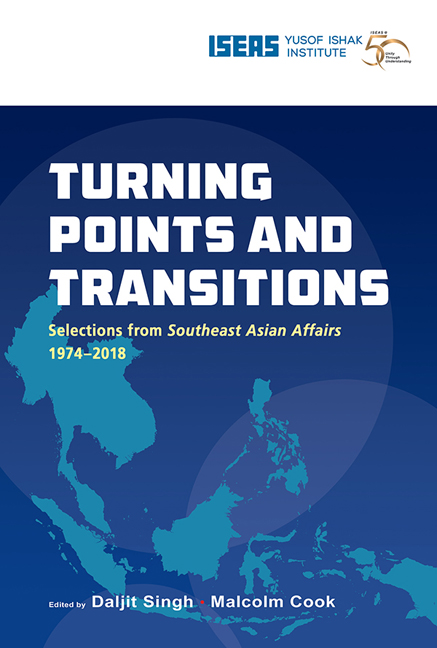Book contents
- Frontmatter
- Contents
- Message from the Director
- Foreword
- Foreword
- Introduction
- THE REGION
- BRUNEI
- CAMBODIA
- INDONESIA
- LAOS
- MALAYSIA
- MYANMAR
- THE PHILIPPINES
- SINGAPORE
- THAILAND
- VIETNAM
- Vietnam in Perspective (1975)
- Year One of Postcolonial Vietnam (1977)
- Vietnam, ASEAN and the Indochina Refugee Crisis (1980)
- Vietnam and ASEAN: A First Anniversary Assessment (1997)
Vietnam, ASEAN and the Indochina Refugee Crisis (1980)
from VIETNAM
Published online by Cambridge University Press: 29 May 2019
- Frontmatter
- Contents
- Message from the Director
- Foreword
- Foreword
- Introduction
- THE REGION
- BRUNEI
- CAMBODIA
- INDONESIA
- LAOS
- MALAYSIA
- MYANMAR
- THE PHILIPPINES
- SINGAPORE
- THAILAND
- VIETNAM
- Vietnam in Perspective (1975)
- Year One of Postcolonial Vietnam (1977)
- Vietnam, ASEAN and the Indochina Refugee Crisis (1980)
- Vietnam and ASEAN: A First Anniversary Assessment (1997)
Summary
The problems posed by the exodus of people from Indochina were of critical concern to all the Association of Southeast Asian Nations (ASEAN) members in 1979. Thailand, the first ASEAN state to be seriously affected by the post-1975 outflow, had had to receive tens of thousands of overland refugees, primarily from Laos. By comparison with the influx from Laos into Thailand, the scale of the outflow from Vietnam in the first three years after 1975 was relatively small; about 35,000 “boat people” had arrived in ASEAN states by mid-1978. After mid-1978, however, the serious refugee situation in Southeast Asia was aggravated further by a mass departure of people from Vietnam, in a process that became the focus of worldwide attention and concern.
The exodus of Indochinese refugees after 1975 was, of course, only one instance of a series of movements of people in Southeast Asia in recent decades. Since World War II, there have been many such mass movements of people in the wake of political change and internal conflicts — movements which have occurred both within countries (most notably, the mass creation of refugees inside the Indochina states during the Second Indochina War), and between different states (the exodus of people, predominantly Catholics, from the northern to the southern zone in Vietnam in 1954, and the movement of Muslims from Southern Philippines to Sabah from the late 1960s and from Burma to Bangladesh in the late 1970s). All these population movements involved extensive social and economic disruption and human suffering. The Indochina refugee movements after 1975, however, became the focus of regional concern, and international attention and diplomatic activity of a kind not directed towards other refugee situations in Southeast Asia in recent years.
Partly a result of the legacy of thirty years of conflict and partly stemming from internal policies pursued by the Indochina states and from the tensions generated by the Sino-Vietnamese conflict, the Indochina refugee exodus has been a source of enormous human and political problems. For the refugees themselves, it has involved intense suffering and often death, particularly during the voyages in overcrowded boats across the often dangerous waters of the South China Sea.
- Type
- Chapter
- Information
- Turning Points and TransitionsSelections from Southeast Asian Affairs 1974-2018, pp. 738 - 761Publisher: ISEAS–Yusof Ishak InstitutePrint publication year: 2018

